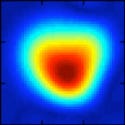Xenon-based method for enhanced MRI resolution
November 13, 2009
Originally Published MPMN November/December 2009
TOP TECHNOLOGIES
Top 20 Technologies of 2009 (Page 3)

|
Xenon-based method for enhanced MRI resolution
Innovator: Lawrence Berkeley National Laboratory (Berkeley, CA)
Why it's unique: Hyperpolarized xenon signal amplification by gas extraction (Hyper-SAGE) can increase an MRI signal up to 10,000 times, according to a group of researchers. Exhibiting such hypersensitivity could contribute to better patient care by improving in vivo diagnostic and molecular imaging applications. In particular, such sensitivity could enable the detection of minute concentrations of diseases, including lung cancer.
Read more about this technology.
Mussel-glue-based medical adhesive
Innovator: North Carolina State University (NC State; Raleigh)
Why it's unique: Going back to nature, researchers have made a novel adhesive breakthrough using mussels. By coupling natural mussel protein adhesive with ink-jet technology, the scientists are helping to pave the way for custom medical adhesives that could be used in postsurgical eye wound repair, fracture fixation, wound closure, drug delivery, and other applications.
Read more about this technology.
Gold-based nanomaterial for biomedical sensing
Innovator: Oregon State University (Corvallis, OR); Univeristé de Méditerranée (Marseille, France); École Polytechnique de Montréal (Canada); and Queen's University (Belfast, UK)
Why it's unique: Everyone's looking to achieve the superlative in the medical device industry. A collaborative research project may have achieved it this year with the creation of an ultrasensitive plasmonic nanorod metamaterial. The researchers responsible for the unique material claim that it exhibits 10 times the sensitivity of current technologies, which could allow for significant progress in biosensing.
Read more about this technology.
|
Harnessing surface acoustic waves for microfluidic devices
Innovator: Monash University (Victoria, Australia)
Why it's unique: Controlling small amounts of liquid, in the case of microfluidics, has proven difficult because of high surface tension. To avoid using a large, unwieldy pump, as is the norm, a group of researchers has employed surface acoustic waves (SAWs) to vibrate and break up droplets of liquid. Fluid transportation via SAW-based technology could enhance microfluidic device design as well as present new opportunities in drug-delivery applications.
Read more about this technology.
Transducer for the miniaturization of surgical cutting instruments
Innovator: Glasgow University (UK); Loughborough University (Leicestershire, UK); Edinburgh University (UK)
Why it's unique: Current ultrasonic cutting devices are resonant, which determines the size and geometry of a given instrument. In an attempt to lift the design restrictions imposed by resonance, researchers in the UK are incorporating flextensional transducers into cutting instruments. Using these transducers allows for more-accurate incisions and the miniaturization of cutting instruments, thereby paving the way for new minimally invasive procedures involving the spine and face.
Read more about this technology.
Copyright ©2009 Medical Product Manufacturing News
You May Also Like



.png?width=300&auto=webp&quality=80&disable=upscale)
